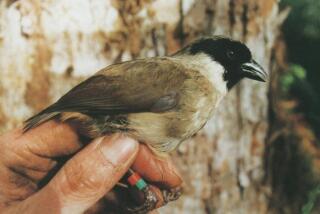Speaking Of: : On Their Last Legs? : World Wildlife Fund’s Top 10 Threatened Species
- Share via
The world’s vulnerable creatures have a friend in CITES, the Convention on International Trade in Endangered Species of Wild Fauna and Flora. In just two decades, the group has grown from 21 to 123 nations devoted to identifying threatened plant and animal species and regulating trade in them.
This fall has been especially active. The private World Wildlife Fund, one of the CITES founding groups, releases its second annual list of species most threatened by international trade. And this week, delegates from CITES nations, private groups, traders, hunters and others are meeting in Fort Lauderdale, Fla., to review the status of about 200 species.
*
Red and Blue Lory (Eos histrio)
Habitat: Three Indonesian islands
Threat: Explosion in international pet and collector trade.
Estimated Population: less than 3,000.
*
Saiga Antelope (Saiga tatarica)
Habitat: Mongolia and Russia
Threat: Poaching. Saiga horn is used in traditional Chinese medicines in combination with horns of other animals, such as the rhino.
Estimated population: Unknown.
*
Asiatic Black Bear (Ursus thibetanus)
Habitat: East and southern Asia
Threat: poaching for gallbladders, which are used in traditional medicines.
Estimated Population: Unknown.
*
Himalayan Yew (Taxus wallichiana)
Habitat: Bhutan, Afghanistan, Pakistan, India, Nepal, Myanmar and possibly China.
Threat: The anti-cancer agent taxol is taken from the yew, a slow growing conifer. Heavy collection for taxol extraction, in addition to general deforestation are contributors to its decline. Nearly 22 pounds of yew leaves, bark and needles are required to make one gram of taxol.
Estimated Population: Unknown.
*
Black Rhino (Diceros bicornis)
Habitat: East and southern Africa
Threats: poaching for horns, which are used for dagger handles or ground into powder for traditional medicines.
Estimated population: Fewer than 2,000.
*
Tiger (Panthera tigris)
Habitat: Asia, particularly Siberia, and tropical regions including Southeast Asia.
Threats: Habitat loss, poaching.
Estimated population: Fewer than 6,000
*
Hawksbill Sea Turtle (Eretmochelys imbricata)
Habitat: tropical reefs, Atlantic, Pacific and Indian oceans.
Threat: poaching for souvenirs and trinkets.
Estimated population: Unknown.
*
Atlantic Bluefin Tuna (Thunnus thynnus)
Habitat: Atlantic Ocean, nearly pole to pole.
Threat: Overfishing.
Estimated population: The Atlantic population of this species has declined 80% over the last 20 years.
*
Giant Panda (Ailuropoda melanoleuca)
Habitat: China
Threat: habitat loss.
Estimated Population: Fewer than 1,000
*
Egyptian Tortoise (Testudo kleinmanni)
Habitat: Desert climates, including Egypt, Israel and Libya.
Threat: Poaching for use as an ingredient in fertility medicines, as well as market sale as pets.
Estimated Population: Unknown.
Sources: GILLIAN HAGGERTY, World Wildlife Fund, CITES.
Compiled by Times researcher LAURA A. GALLOWAY
Design: MATT MOODY / Los Angeles Times
More to Read
Sign up for Essential California
The most important California stories and recommendations in your inbox every morning.
You may occasionally receive promotional content from the Los Angeles Times.













